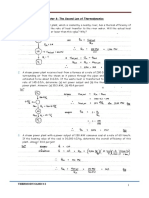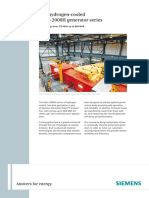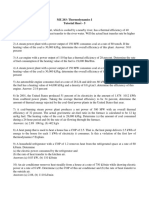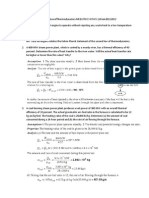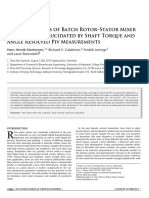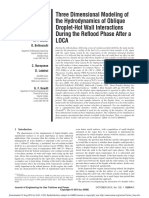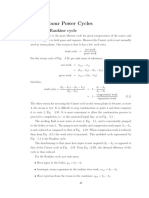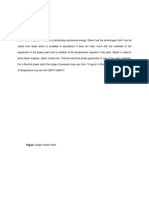0 ratings0% found this document useful (0 votes)
488 viewsSheet
Sheet
Uploaded by
Mohamed MaherThe document contains questions about thermodynamics concepts including the first and second laws of thermodynamics, heat engines, refrigerators, heat pumps, and Carnot cycles. Some key points addressed are:
- Processes that satisfy or violate the first and second laws of thermodynamics
- Thermal energy reservoirs and examples like oven air or TV set waste heat
- Characteristics of heat engines like their inability to operate without heat rejection
- Calculating efficiency and other values for heat engines, refrigerators, and heat pumps operating between temperature reservoirs
- Reversible and irreversible processes like the warming of a canned drink
- Components and principles of the Carnot cycle and how it relates to maximum efficiency
Copyright:
© All Rights Reserved
Available Formats
Download as DOCX, PDF, TXT or read online from Scribd
Sheet
Sheet
Uploaded by
Mohamed Maher0 ratings0% found this document useful (0 votes)
488 views4 pagesThe document contains questions about thermodynamics concepts including the first and second laws of thermodynamics, heat engines, refrigerators, heat pumps, and Carnot cycles. Some key points addressed are:
- Processes that satisfy or violate the first and second laws of thermodynamics
- Thermal energy reservoirs and examples like oven air or TV set waste heat
- Characteristics of heat engines like their inability to operate without heat rejection
- Calculating efficiency and other values for heat engines, refrigerators, and heat pumps operating between temperature reservoirs
- Reversible and irreversible processes like the warming of a canned drink
- Components and principles of the Carnot cycle and how it relates to maximum efficiency
Original Description:
Final
Original Title
Sheet[5]
Copyright
© © All Rights Reserved
Available Formats
DOCX, PDF, TXT or read online from Scribd
Share this document
Did you find this document useful?
Is this content inappropriate?
The document contains questions about thermodynamics concepts including the first and second laws of thermodynamics, heat engines, refrigerators, heat pumps, and Carnot cycles. Some key points addressed are:
- Processes that satisfy or violate the first and second laws of thermodynamics
- Thermal energy reservoirs and examples like oven air or TV set waste heat
- Characteristics of heat engines like their inability to operate without heat rejection
- Calculating efficiency and other values for heat engines, refrigerators, and heat pumps operating between temperature reservoirs
- Reversible and irreversible processes like the warming of a canned drink
- Components and principles of the Carnot cycle and how it relates to maximum efficiency
Copyright:
© All Rights Reserved
Available Formats
Download as DOCX, PDF, TXT or read online from Scribd
Download as docx, pdf, or txt
0 ratings0% found this document useful (0 votes)
488 views4 pagesSheet
Sheet
Uploaded by
Mohamed MaherThe document contains questions about thermodynamics concepts including the first and second laws of thermodynamics, heat engines, refrigerators, heat pumps, and Carnot cycles. Some key points addressed are:
- Processes that satisfy or violate the first and second laws of thermodynamics
- Thermal energy reservoirs and examples like oven air or TV set waste heat
- Characteristics of heat engines like their inability to operate without heat rejection
- Calculating efficiency and other values for heat engines, refrigerators, and heat pumps operating between temperature reservoirs
- Reversible and irreversible processes like the warming of a canned drink
- Components and principles of the Carnot cycle and how it relates to maximum efficiency
Copyright:
© All Rights Reserved
Available Formats
Download as DOCX, PDF, TXT or read online from Scribd
Download as docx, pdf, or txt
You are on page 1of 4
Sheet (5)
Part (I): Second Law of Thermodynamics and Thermal Energy Reservoirs:
1) Describe an imaginary process that satisfies the first law but violates the
second law of thermodynamics.
2) Describe an imaginary process that satisfies the second law but violates the
first law of thermodynamics.
3) Describe an imaginary process that violates both the first and the second laws
of thermodynamics.
4) An experimentalist claims to have raised the temperature of a small amount of
water to 150C by transferring heat from high-pressure steam at 120C. Is this a
reasonable claim? Why? Assume no refrigerator or heat pump is used in the
process.
5) What is a thermal energy reservoir? Give some examples.
6) Consider the process of baking potatoes in a conventional oven. Can the hot
air in the oven be treated as a thermal energy reservoir? Explain.
7) Consider the energy generated by a TV set. What is a suitable choice for a
thermal energy reservoir?
Part (II): Heat Engines and Thermal Efficiency:
8 ) Is it possible for a heat engine to operate without rejecting any waste heat to
a low-temperature reservoir? Explain.
9 ) What are the characteristics of all heat engines?
10) What is the Kelvin-Planck expression of the second law of thermodynamics?
11) Does a heat engine that has a thermal efficiency of 100 % necessarily violate
(a) the first law and (&) the second law of thermodynamics? Explain.
12) In the absence of any friction and other irreversibility, can a heat engine have
an efficiency of 100 %? Explain.
13) A steam power plant receives heat from a furnace at a rate of 280 GJ/h.
Heat losses to the surrounding air from the steam as it passes through the pipes
and other components are estimated to be about 8 GJ/h. If the waste heat is
transferred to the cooling water at a rate of 145 GJ/h, determine (a) net power
output and (b) the thermal efficiency of this power plant. [Answer: (a)35.3MW, (b) 45%]
14) A steam power plant with a power output of 150 MW consumes coal at a
rate of 60 tons/hr. If the heating value of the coal is 30,000 kJ/kg, determine the
overall efficiency of this plant. [Answer: 30%]
15) An automobile engine consumes fuel at a rate of 28L/h and delivers 60 kW
of power to the wheels. If the fuel has a heating value of 44,000 kJ/kg and a
density of 0.8 g/cm. determine the efficiency of this engine. [Answer: 21.9%]
16) A coal-burning steam power plant produces a net power of 300 MW with an
overall thermal efficiency of 32 %. The actual gravimetric air-fuel ratio in the
furnace is calculated to be 12 kg air/kg fuel. The heating value of the coal is
28,000 kJ/kg. Determine (a) the amount of coal consumed during a 24-hour
period and (b) the rate of air flowing through the furnace.
[Answer: (a) 2.89 x 10
6
kg, (b) 402 kg/s]
Part (III): Refrigerators and heat Pumps:
17) What is the difference between a refrigerator and a heat pump?
18) What is the difference between a refrigerator and an air conditioner?
19) Define the coefficient of performance of a refrigerator. Can it be greater than
unity?
20) Define the coefficient of performance of a heat pump. Can it be greater than
unity?
21) What is the Clausius expression of the second law of thermodynamics?
22) Show that the Kelvin-Planck and the Clausius expressions of the second law
are equivalent.
23) A household refrigerator with a COP of 1.2 removes heat from the
refrigerated space at a rate of 60 kJ/min. Determine (a) the electric power
consumed by the refrigerator and (b) the rate of heat transfer to the kitchen air.
[Answer: (a) 0.83 KW, (b) 110 KJ/min.]
24) Determine the COP of a heat pump that supplies energy to a house at a rate
of 8000 kJ/hr for each kW of electric power it draws. Also, determine the rate of
energy absorption from the outdoor air. [Answer: 2.22, 4400 KJ/h.]
25) A heat pump is used to maintain a house at a constant temperature of 23C.
The house is losing heat to the outside air through the walls and the windows at
a rate of 60,000 kJ/hr while the energy generated within the house from people,
lights, and appliances amounts to 4000 kJ/tr. For a COP of 2.5, determine the
required power input to the heat pump. [Answer: 6.22 KW]
Part (IV): Reversible and Irreversible Processes:
26) A cold canned drink is left in a warmer room where its temperature rises as
a result of heat transfer. Is this a reversible process? Explain.
27) Why are engineers interested in reversible processes even though they can
never be achieved?
28) What are the four processes that make up the Carnot cycle?
29) What are the two statements known as the Carnot principles?
30) Somebody claims to have developed a new reversible heat-engine cycle that
has a higher theoretical efficiency than the Carnot cycle operating between the
same temperatures limits. How do you evaluate this claim?
31) Somebody claims to have developed a new reversible heat-engine cycle
that has the same theoretical efficiency as the Carnot cycle operating between
the same temperature limits. Is this a reasonable claim?
32) Is it possible to develop (a) an actual and (b) a reversible heat-engine cycle
that is more efficient than a Carnot cycle operating between the same
temperature limits? Explain.
Part (V): Carnot Heat Engines:
33) Is there any way to increase the efficiency of a Carnot heat engine other than
by increasing T
H
, or decreasing ,T
L
,
34) A Carnot heat engine operates between a source at 1000 K and a sink at
300 K. If the heat engine is supplied with heat at a rate of 800 kJ/min, determine
(a) the thermal efficiency and (b) the power output of this heat engine.
Answers: [(a) 70%, (b) 9.33 kW.]
35) An innovative way of power generation involves the utilization of geothermal
energy, the energy of hot water that exists naturally underground, as the heat
source. If a supply of hot water at 140C is discovered at a location where the
environmental temperature is 20C, determine the maximum thermal efficiency a
geothermal power plant built at that location can have.
[Answer: 29 1 %]
Part (VI): Carnot Refrigerators and Heat Pumps:
36) How can we increase the COP of a Carnot refrigerator?
37) What is the highest COP that a refrigerator operating between temperature
levels T
L
and T
H
can have?
38) A refrigerator is to remove heat from the cooled space at a rate of 300kJ/min
to maintain its temperature at -8C.If the air surrounding the refrigerator is at
25C, determine the minimum power input required for this refrigerator.
[Answer: 0.623]
39) An air-conditioning system operating on the reversed Carnot cycle is
required to transfer heat from a house at a rate of 750 kJ/min to maintain its
temperature at 24C. If the outdoor air temperature is 35C, determine the power
required to operate this air-conditioning system. [Answer: 0.46]
40) A Carnot refrigerator operates in a room in which the temperature is 25C.
The refrigerator consumes 500 W of power when operating and has a COP of
4.5. Determine (a) the rate of heat removal from the refrigerated space and (b)
the temperature of the refrigerated space. Answers: [(a) 135KJ/min., (b) -29.2 C]
41) The structure of a house is such that it loses heat at a rate of 5400 kJ/h per
C difference between the indoors and outdoors. A heat pump that requires a
power input of 6 kW is used to maintain this house at 2lC. Determine the lowest
outdoor temperature for which the heat pump can meet the heating requirements
of this house. Answers: [ -13.3C]
42) A Carnot heat pump is to be used to heat a house and maintain it at 20C in
winter. On a day when the average outdoor temperature remains at about 2C,
the house is estimated to lose heat at a rate of 82,000 kJ/h. If the heat pump
consumes 8 kW of power while operating, determine (a) how long the heat pump
ran on that day; (b) the total heating costs, assuming an average price of
8.5/kWh for electricity; and (c) the heating cost for the same day if resistance
heating is used instead of a heat pump. Answers: [(a) 4.19 h, (b)$ 2.85 kW, (c) $46.47]
43) A Carnot heat engine receives heat from a reservoir at 900C at a rate of
800 kJ/min and rejects the waste heat to the ambient air at 27C. The entire work
output of the heat engine is used to drive a refrigerator that removes heat from
the refrigerated space at -5C and transfers it to the same ambient air at 27C.
Determine (a) the maximum rate of heat removal from the refrigerated space and
(b) the total rate of heat rejection to the ambient air.
Answers: [(a) 4982 KJ/min, (b) 5682 KJ/min]
You might also like
- Sheet 4Document1 pageSheet 4Ahmed Rabie Abd Elazeem100% (1)
- Thermo - 6Document14 pagesThermo - 6Xcos0% (1)
- Steam Power Plant Standard Operating ProceduresDocument4 pagesSteam Power Plant Standard Operating Proceduresarvidkumar8706050% (4)
- Concentrated Solar Thermal Energy Technologies Recent Trends and Applications by Laltu ChandraDocument264 pagesConcentrated Solar Thermal Energy Technologies Recent Trends and Applications by Laltu ChandraIBRAHIMA diop100% (1)
- Project Work Mba Finance 2012 D. GopiDocument72 pagesProject Work Mba Finance 2012 D. GopiRamesh AnkathiNo ratings yet
- Power Plant Engineering Chapter 1 PDFDocument8 pagesPower Plant Engineering Chapter 1 PDFGETACHEW100% (1)
- The Hydrogen-Cooled Sgen-2000H Generator Series: Answers For EnergyDocument4 pagesThe Hydrogen-Cooled Sgen-2000H Generator Series: Answers For EnergyYaman ghayadNo ratings yet
- Day 2 1 PDFDocument17 pagesDay 2 1 PDFChristianNo ratings yet
- Tutorial Sheet 5Document2 pagesTutorial Sheet 5Syed YousufuddinNo ratings yet
- Topic 9 ThermodynamicsDocument4 pagesTopic 9 ThermodynamicsTengku Lina IzzatiNo ratings yet
- Tut1 15S2Document1 pageTut1 15S2Yih Lin ChenNo ratings yet
- Second Law Thermodynamics AssignmentDocument2 pagesSecond Law Thermodynamics AssignmentNazirul Masuk AyorNo ratings yet
- Faculty of Engineering Department of Mechanical and Marine Engineering Thermodynamics (TDN620S)Document4 pagesFaculty of Engineering Department of Mechanical and Marine Engineering Thermodynamics (TDN620S)Wilbard IitulaNo ratings yet
- BT Quiz - 2Document8 pagesBT Quiz - 2Navdha KapoorNo ratings yet
- 5 Second Law Tutorial PDFDocument2 pages5 Second Law Tutorial PDFReymar BelmonteNo ratings yet
- Module 2-THERMODYNAMICS-problems-2024-sent - Physic1Document2 pagesModule 2-THERMODYNAMICS-problems-2024-sent - Physic123129290No ratings yet
- Second Law of Thermodynamics Practice Questions - Without AnsDocument4 pagesSecond Law of Thermodynamics Practice Questions - Without AnsKirti KumarNo ratings yet
- Che325 Tutorial KitDocument10 pagesChe325 Tutorial KitCharles BaileyNo ratings yet
- Sheet 6 ThermodynamicsDocument2 pagesSheet 6 ThermodynamicsMario SamehNo ratings yet
- Sheet 6 SolutionDocument14 pagesSheet 6 SolutionMadridSpainNo ratings yet
- Carnot Engine Trial QuestionsDocument1 pageCarnot Engine Trial QuestionsMawanda SimonNo ratings yet
- Mock Test - 2 ThermodynamicsDocument10 pagesMock Test - 2 Thermodynamicsvipin kumarNo ratings yet
- Chapter 22 Problems 1,, Straightforward, IntermediateDocument12 pagesChapter 22 Problems 1,, Straightforward, Intermediatecobalt boronNo ratings yet
- ENGR 205 Assignment#5Document2 pagesENGR 205 Assignment#5s-basma.mokhtarNo ratings yet
- 2nd Law of Thermodynamics - Problems PDFDocument5 pages2nd Law of Thermodynamics - Problems PDFEduardo VCNo ratings yet
- Tut Sheet 5-2nd LawDocument2 pagesTut Sheet 5-2nd LawVIJAYRAJ SINGHNo ratings yet
- AREN 2110 Sections 001 and 002 Fall 2007 Homework # 8: Due Thursday, Nov. 1Document1 pageAREN 2110 Sections 001 and 002 Fall 2007 Homework # 8: Due Thursday, Nov. 1Mohiuddin AhmedNo ratings yet
- Answer Problem Sheet-05 Me201 2nd LawDocument9 pagesAnswer Problem Sheet-05 Me201 2nd LawshantanuNo ratings yet
- HW06Document2 pagesHW06redman234No ratings yet
- 7157902Document62 pages7157902Red RedNo ratings yet
- Sheet5 Thermo Elect.Document3 pagesSheet5 Thermo Elect.AHMED BAKRNo ratings yet
- Assignment 2Document2 pagesAssignment 2KARTHICK MNo ratings yet
- HW07 Ch07 2nd Law CarnotDocument3 pagesHW07 Ch07 2nd Law Carnotabdoag1691998No ratings yet
- Solve Sheet 1Document26 pagesSolve Sheet 1joelshiekh9No ratings yet
- Question Bank H 1Document3 pagesQuestion Bank H 1Trupti bagalNo ratings yet
- ThermoDocument3 pagesThermopranavNo ratings yet
- Tutorial 4 - Carnot and Introduction To EntropyDocument4 pagesTutorial 4 - Carnot and Introduction To EntropyasdfsdjhNo ratings yet
- Chapter 6 TutorialsDocument5 pagesChapter 6 TutorialsHafizi Naim IsmailNo ratings yet
- 22me32 Etd Unit-Iii Problem SheetDocument4 pages22me32 Etd Unit-Iii Problem SheetVinayaka D MNo ratings yet
- Practice QuestionsDocument2 pagesPractice QuestionsDavid Anold DubeNo ratings yet
- HW8VM235SU2016Document2 pagesHW8VM235SU2016tony960129No ratings yet
- Kishore AtdDocument14 pagesKishore AtdKumar SamyanaikNo ratings yet
- MEE 302 - Tutorial 1Document2 pagesMEE 302 - Tutorial 1acemumbiNo ratings yet
- 2nd Law of Thermodynamics WorksheetDocument2 pages2nd Law of Thermodynamics WorksheetMoa ArmyNo ratings yet
- Question PART 4 (2023)Document7 pagesQuestion PART 4 (2023)Phong ĐặngNo ratings yet
- Thermodynamics 2 - Quiz #2 (Set A) : 1 1-k 1 K 2 1-k 2 KDocument2 pagesThermodynamics 2 - Quiz #2 (Set A) : 1 1-k 1 K 2 1-k 2 KCabagnot Piolo JuliusNo ratings yet
- Me6301 Engineering Thermodynamics Nov Dec 2011Document3 pagesMe6301 Engineering Thermodynamics Nov Dec 2011BIBIN CHIDAMBARANATHANNo ratings yet
- Tutorial 2Document2 pagesTutorial 2Angelina PutriNo ratings yet
- Problem Set2ndlawwithanswersDocument4 pagesProblem Set2ndlawwithanswersGy Ra0% (1)
- Supplementary Problems 5.10 A Heat Pump ProvidesDocument3 pagesSupplementary Problems 5.10 A Heat Pump Providesshodik8426134No ratings yet
- Tutorial Sheet 02 2014Document11 pagesTutorial Sheet 02 2014checkmeout803No ratings yet
- Assaingment Rac 1Document6 pagesAssaingment Rac 1Hariom MouryaNo ratings yet
- Tutorial 6 - Second Law Analysis and Refrigeration Cycles PDFDocument3 pagesTutorial 6 - Second Law Analysis and Refrigeration Cycles PDFasdfsdjhNo ratings yet
- Thermodynamics工程热力学英文例题2Document3 pagesThermodynamics工程热力学英文例题2YmNo ratings yet
- Tut 6,7,8 - 2013Document3 pagesTut 6,7,8 - 2013SourabhNo ratings yet
- Test #2Document3 pagesTest #2Dar QuetzalNo ratings yet
- Assignment_04_1729788554394395176671a7a8a31e31Document4 pagesAssignment_04_1729788554394395176671a7a8a31e31abhinavkumar3607No ratings yet
- A. Latent Heat: M 0.140 KG, CP 3600J/ (KGDocument16 pagesA. Latent Heat: M 0.140 KG, CP 3600J/ (KGArnel SisonNo ratings yet
- Thermo Tutorial 5 and 6Document4 pagesThermo Tutorial 5 and 6Aditya MallickNo ratings yet
- Me2202 - EtDocument7 pagesMe2202 - EtAnonymous mRBbdopMKfNo ratings yet
- Assignment 2 FinalDocument3 pagesAssignment 2 Finalhamimmuhammedadem0579No ratings yet
- Me6301 Engineering Thermodynamics - Uq - May June 2016Document4 pagesMe6301 Engineering Thermodynamics - Uq - May June 2016BIBIN CHIDAMBARANATHANNo ratings yet
- 1610130042Document2 pages1610130042Kuldeep ShrivastavaNo ratings yet
- Catalysts: Catalyst Stability Assessment in A Lab-Scale Liquid-Solid (LS) Plug-Flow ReactorDocument17 pagesCatalysts: Catalyst Stability Assessment in A Lab-Scale Liquid-Solid (LS) Plug-Flow ReactorMohamed MaherNo ratings yet
- General Description: Digital Temperature ControllerDocument6 pagesGeneral Description: Digital Temperature ControllerMohamed MaherNo ratings yet
- Optimal Jacketed Tubular Reactor Operation ClassicDocument7 pagesOptimal Jacketed Tubular Reactor Operation ClassicMohamed MaherNo ratings yet
- On Image Pre-Processing For PIV of Single-And Two-Phase Ows Over Re Ecting ObjectsDocument7 pagesOn Image Pre-Processing For PIV of Single-And Two-Phase Ows Over Re Ecting ObjectsMohamed MaherNo ratings yet
- Electrical Conductivity of Aqueous Sodium Hydroxide Solutions at High TemperaturesDocument11 pagesElectrical Conductivity of Aqueous Sodium Hydroxide Solutions at High TemperaturesMohamed MaherNo ratings yet
- Eaav8081 FullDocument7 pagesEaav8081 FullMohamed MaherNo ratings yet
- Aalborg Universitet: User GuideDocument43 pagesAalborg Universitet: User GuideMohamed MaherNo ratings yet
- Fluid Power - (ME353) - Lec11-LogicDocument21 pagesFluid Power - (ME353) - Lec11-LogicMohamed MaherNo ratings yet
- Characteristics of Batch Rotor-Stator Mixer Performance Elucidated by Shaft Torque and Angle Resolved Piv MeasurementsDocument20 pagesCharacteristics of Batch Rotor-Stator Mixer Performance Elucidated by Shaft Torque and Angle Resolved Piv MeasurementsMohamed MaherNo ratings yet
- Titration Calculations: Calculating A ConcentrationDocument3 pagesTitration Calculations: Calculating A ConcentrationMohamed MaherNo ratings yet
- Three Dimensional Modeling of The Hydrodynamics of Oblique Droplet-Hot Wall Interactions During The Reflood Phase After A LocaDocument6 pagesThree Dimensional Modeling of The Hydrodynamics of Oblique Droplet-Hot Wall Interactions During The Reflood Phase After A LocaMohamed MaherNo ratings yet
- Effective Equality SurveysDocument41 pagesEffective Equality SurveysMohamed MaherNo ratings yet
- Control SpecificationsDocument2 pagesControl SpecificationsMohamed MaherNo ratings yet
- Fluid Power - (ME353) - Lec6Document37 pagesFluid Power - (ME353) - Lec6Mohamed MaherNo ratings yet
- Fluid Power Systems - Sheet 2Document4 pagesFluid Power Systems - Sheet 2Mohamed Maher100% (1)
- Diagram MeDocument37 pagesDiagram MeMohamed MaherNo ratings yet
- Curriculum VitaeDocument2 pagesCurriculum VitaeMohamed MaherNo ratings yet
- Sheet 3Document1 pageSheet 3Mohamed MaherNo ratings yet
- Fluid Power - (ME353) - Lec2Document64 pagesFluid Power - (ME353) - Lec2Mohamed MaherNo ratings yet
- Fluid Power - (ME353) - Lec10Document35 pagesFluid Power - (ME353) - Lec10Mohamed MaherNo ratings yet
- CH 4 Analog MeasurandDocument25 pagesCH 4 Analog MeasurandMohamed MaherNo ratings yet
- Dokumen - Tips - Ficci List of Invities For Pat Awareness ProgramDocument50 pagesDokumen - Tips - Ficci List of Invities For Pat Awareness Programsmita6nayak0% (1)
- Danstoker AS Catalogue v. ENDocument8 pagesDanstoker AS Catalogue v. ENlogoslayoutNo ratings yet
- Financial Statement AnalysisDocument81 pagesFinancial Statement AnalysisVijay Kamal100% (1)
- EME 2315 Chapter 5Document9 pagesEME 2315 Chapter 5Andy OchiengNo ratings yet
- Etd QB 2021Document11 pagesEtd QB 2021KEERTHIVASAN R MechNo ratings yet
- Micro Project: Latthe Education Society's Polytechnic, SangliDocument26 pagesMicro Project: Latthe Education Society's Polytechnic, SangliAtharv SalunkheNo ratings yet
- NPTEL Assignments Power Plant EngineeringDocument18 pagesNPTEL Assignments Power Plant EngineeringShubhendra Yadav100% (2)
- Btech Electrical 7 Sem Power Station Engineering and Economy Pee7g001 2020Document2 pagesBtech Electrical 7 Sem Power Station Engineering and Economy Pee7g001 2020Swarup MohapatraNo ratings yet
- DPRDocument119 pagesDPRAnonymous WsdOELHpoqNo ratings yet
- Thermal Power PlantDocument33 pagesThermal Power PlantManoj KumarNo ratings yet
- ME8391-Engineering Thermodynamics PDFDocument20 pagesME8391-Engineering Thermodynamics PDFbharathNo ratings yet
- Thermal Power PlantDocument17 pagesThermal Power PlantraghuvarmaNo ratings yet
- DNV-RP-A202 Documentation of Offshore Projects.Document12 pagesDNV-RP-A202 Documentation of Offshore Projects.leeNo ratings yet
- Pub112 LNG Propulsion GuideDec05Document60 pagesPub112 LNG Propulsion GuideDec05Priscila KImNo ratings yet
- DVC Mejia ReportDocument37 pagesDVC Mejia ReportRahul RoyNo ratings yet
- Bme Digital NotesDocument88 pagesBme Digital NotesAkshay KharmateNo ratings yet
- Thermoflow OutputDocument40 pagesThermoflow Outputtiarrubuh100% (1)
- Model Solutions: Supplimentary Paper 1 - Set ADocument19 pagesModel Solutions: Supplimentary Paper 1 - Set ACARPE NOCTEMNo ratings yet
- Cooling Tower Project ReportDocument35 pagesCooling Tower Project Reportdilliprout.caplet2016No ratings yet
- ElectricalElectronics EngineeringDocument36 pagesElectricalElectronics EngineeringSuraj Kumar SinghNo ratings yet
- Technical ManualDocument32 pagesTechnical ManualIstvan MadacsyNo ratings yet
- Evaporative CoolerDocument6 pagesEvaporative Coolersujiv_sujiv1278No ratings yet
- Operation & Maintenance Guide For Dry Ash Evacuation & Transportation System - OperationDocument24 pagesOperation & Maintenance Guide For Dry Ash Evacuation & Transportation System - OperationArun RajNo ratings yet


